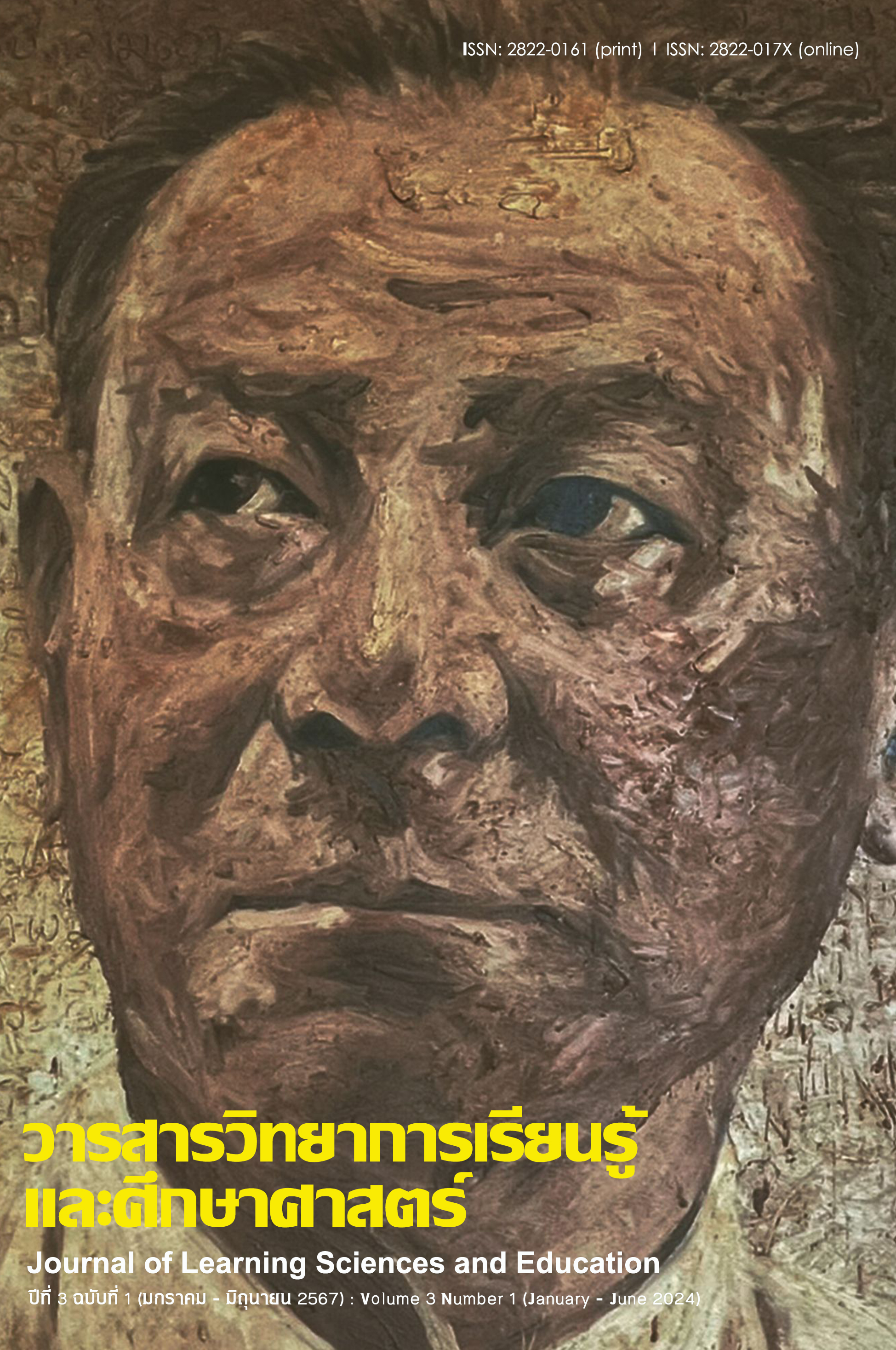กระบวนการพัฒนาทักษะการสื่อสารอย่างมีประสิทธิภาพสำหรับนักเรียนระดับประถมศึกษาในยุคดิจิทัลด้วยกระบวนการ ACTMARR 7 ขั้นตอน
Main Article Content
บทคัดย่อ
ในโลกปัจจุบัน นับเป็นยุคดิจิทัลที่ข้อมูลและความรู้มีอยู่อย่างหลากหลาย ความสามารถในการนำเสนอความคิดเห็นและข้อมูลอย่างมีเหตุผลและเป็นระบบเป็นทักษะที่ท้าทายแต่จำเป็นอย่างยิ่ง ทักษะการนำเสนอที่ดีช่วยให้นักเรียนสามารถจัดเรียงข้อมูล ใช้เหตุผลและเชื่อมโยงความคิดได้อย่างชัดเจน เพื่อสร้างผลกระทบที่มีประสิทธิภาพและยั่งยืนในผู้ฟัง การจัดการเรียนรู้ที่เน้นทักษะเหล่านี้เป็นส่วนสำคัญในการพัฒนาอนาคตของเด็ก ๆ เพราะการเรียนรู้ที่มีประสิทธิภาพไม่ได้เกิดขึ้นจากการจำข้อมูลเท่านั้น แต่เกิดจากการทำความเข้าใจ การสื่อสาร และการนำเสนอความรู้นั้นออกไป การสอนทักษะเหล่านี้จึงช่วยเสริมสร้างกรอบการคิดที่สำคัญสำหรับนักเรียน เพื่อให้พวกเขาพร้อมสำหรับการแก้ไขปัญหา การคิดอย่างมีวิจารณญาณ และการสร้างสรรค์นวัตกรรมในอนาคต โดยบทความนี้มีวัตถุประสงค์เพื่อนำเสนอกระบวนการพัฒนาทักษะการสื่อสารอย่างมีประสิทธิภาพสำหรับนักเรียนระดับประถมศึกษาในยุคดิจิทัล ด้วยกระบวนการ ACTMARR 7 ขั้นตอน ประกอบด้วย 1) เข้าใจผู้ฟัง (audience awareness) 2) กำหนดเป้าหมายชัดเจน (clarity of purpose) 3) การเลือกเนื้อหาอย่างรอบคอบ (thoughtful selection) 4) การฝึกฝนอย่างเชี่ยวชาญผ่านกิจกรรมหลากหลาย (masterful practice) 5) การใช้เทคโนโลยีอย่างเหมาะสม (adaptive technology utilization) 6) สะท้อนผลอย่างเข้าใจ (reflective feedback) และ 7) การนำผลที่ได้ไปปรับใช้ (refinement through application) ซึ่งกระบวนการเหล่านี้จะส่งเสริมการสื่อสารอย่างชัดเจนและการนำเสนอที่สร้างผลกระทบ ตั้งแต่การเข้าใจผู้ฟังไปจนถึงการนำผลที่ได้ไปปรับใช้ เน้นการเรียนรู้ที่มีส่วนร่วมและส่งเสริมกระบวนการคิดวิเคราะห์และคิดอย่างมีวิจารณญาณ เป็นพื้นฐานสำคัญในการพัฒนาทักษะการแก้ปัญหา การคิดอย่างมีวิจารณญาณ และการสร้างสรรค์นวัตกรรม เพื่อสร้างความมั่นใจและความพร้อมให้นักเรียนเติบโตเป็นพลเมืองโลกที่สามารถสื่อสารและนำเสนอได้อย่างมีประสิทธิภาพ และสามารถสร้างผลกระทบในสังคมและวงกว้าง
Article Details

This work is licensed under a Creative Commons Attribution-NonCommercial-NoDerivatives 4.0 International License.
References
Charatsengchirachot, T., & Songkasant, P. (2023). กระบวนการสื่อสาร กลยุทธ์การสื่อสาร และประสิทธิผลของการสื่อสารเพื่อการท่องเที่ยวอย่างยั่งยืนอุทยานแห่งชาติน้ำตกพลิ้ว จังหวัดจันทบุรี. [The Process, Strategies and Effectiveness of Communication in Sustainable Tourism at Namtok Phlio National Park, Chanthaburi Province]. Journal of Communication Arts Review, 27(2), 20-32. Retrieved from https://so06.tci-thaijo.org/index.php/jca/article/view/264040
Dainton, M., & Zelley, E. D. (2022). Applying Communication Theory for Professional Life: A Practical Introduction. California: Sage publications.
Dankbaar, M. E., & de Jong, P. G. (2014). Technology for Learning: How It Has Changed Education. Perspectives on medical education, 3(4), 257-259.
Hannapha, P. (2011). การเขียนเพื่อการสื่อสาร [Writing for communication]. Bangkok: Inthanin press.
Kittiveja, O., Booranaprasertsook, W., Nantachantoon, S., Sereechaikul, T., Tongsumrit, W., Yooyen, W., & Bumrungsuk, S. (2012). ภาษาไทยเพื่อการสื่อสาร [Thai Language for Communication]. Bangkok: Kasetsart University Press.
Klongklaw, R. (2018). การพัฒนารูปแบบการจัดการศึกษาที่มีประสิทธิผลของโรงเรียนมัธยมศึกษาเอกชน สังกัดสำนักงานคณะกรรมการส่งเสริมการศึกษาเอกชน ในเขตภาคตะวันออก [Development Education Management Model of Effectiveness in Private Secondary Schools under Office of Private Education Commission in Eastern Region] (Doctoral dissertation, Burapha University). Chonburi. https://buuir.buu.ac.th/bitstream/1234567890/7237/1/Fulltext.pdf
Mercer, N., & Howe, C. (2012). Explaining the dialogic processes of teaching and learning: The value and potential of sociocultural theory. Learning, Culture and Social Interaction, 1(1), 12-21.
Ministry of Information and Communication Technology. (2016). แผนพัฒนาดิจิทัลเพื่อเศรษฐกิจและสังคม [Digital Development for National Economic and Social Development Plan]. Retrieved from https://onde.go.th/view/1/Digital_Development_for_National_ Economic_and_Social_Development/EN-US
Panich, V. (2017). วิถีสร้างการเรียนรู้เพื่อศิษย์ ในศตวรรษที่ 21 [Authentic Learning for the 21st Century: An Overview]. Walailak Journal of Learning Innovations, 1(2), 3–14. Retrieved from https://so03.tci-thaijo.org/index.php/jliwu/article/view/95054
Peansamer, W. (2023). หลักการสื่อสารที่มีประสิทธิภาพ [Principles of effective communication]. Retrieved from https://pws.npru.ac.th/wasamone/index.php?act=6a992d5529f459a44 fee58c733255e86&lntype=editor_top&stm_id=3184
Petcharat, J., & Tongbai, A. (2013). การอ่านและการเขียนทางวิชาการ [Academic reading and writing]. Bangkok: Odeon store printing.
Pirantaowad, O. (1997). การสื่อสารเพื่อการโน้มน้าวใจ [Persuasive Communication]. Bangkok: Chulalongkorn University Press.
Resnick, L. B., Asterhan, C. S. C., & Clarke, S. N. (Eds.). (2015). Socializing Intelligence Through Academic Talk and Dialogue. American Educational Research Association. http://www.jstor.org/stable/j.ctt1s474m1
Saifah, Y. (2012). แนวการปฏิบัติที่เหมาะสมตามพัฒนาการ (Developmentally Appropriate Practice) ในชั้นเรียนระดับประถมศึกษาตอนต้น: จากกรอบแนวคิดทฤษฎีสู่หลักการปฏิบัติที่เหมาะสม [Developmentally Appropriate Practice in Thai Primary Grade Classrooms: From Theory to Practice]. Journal of Education, 39(2), 120–129.
Sanguannarm, C. (2002). ทฤษฎีและแนวปฏิบัติในการบริหารสถานศึกษา [Theory And Practice In Education Institution]. Bangkok: Book Point.
Satchukorn, S. (2007). การต้อนรับและบริการที่เป็นเลิศ [Excellent hospitality and service]. Bangkok: Saitharn Publishing.
The Vocational Education Commission. (2019). หลักเกณฑ์และแนวปฏิบัติการจัดการอาชีวศึกษา ระดับประกาศนียบัตรวิชาชีพ และระดับประกาศนียบัตรวิชาชีพชั้นสูง [Criteria and guidelines for vocational education management on Vocational Certificate and Higher Vocational Certificate Level]. Bangkok: Office of the Vocational Education Commission (OVEC).
Vygotsky, L. S. (1978). Mind in Society: The Development of Higher Psychological Processes. Cambridge: Harvard University Press.
Yimpluem, J. (2018). ปัจจัยที่ส่งผลต่อประสิทธิภาพการสื่อสารในองค์กรของส านักงาน คณะกรรมการป้องกันและปราบปรามการทุจริตแห่งชาติ(ป.ป.ช.) [Factors Affecting Corporate Communications Efficiency of the Office of the National Anti-Corruption Commission (NACC)] (Individual Study, Dhurakijpundit University). Bangkok. https://libdoc.dpu.ac.th/thesis/Jirawan.Yim.pdf

